Klipsch The Fives Powered Speaker REVIEW
Summary
Klipsch The Fives Powered Speaker REVIEW
A loudspeaker’s a loudspeaker’s a loudspeaker, right? Wrong, discovers ASHLEY KRAMER, who is knocked out by a clever and versatile pair from Klipsch.
$1800
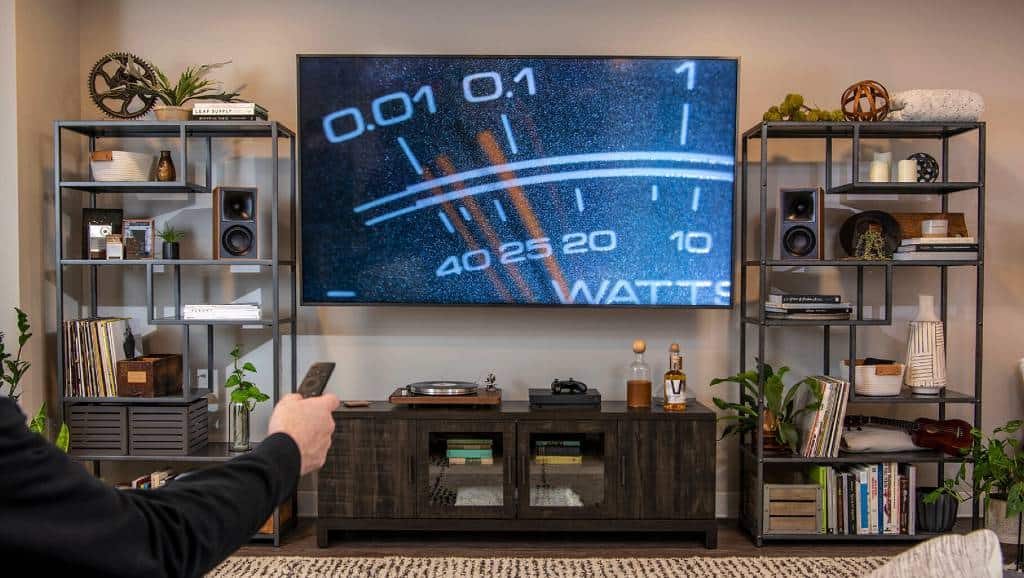
 Home audio has evolved over the years. We’ve moved from a gramophone to a big wooden box in the lounge that combined speakers, turntable, and a receiver, to a rack of separate hi-fi components feeding a pair of standalone speakers. Recently, as tastes have changed and technology has shifted, we’ve had a raft of small wireless music systems that are in theory, meant to replace a hi-fi system
Home audio has evolved over the years. We’ve moved from a gramophone to a big wooden box in the lounge that combined speakers, turntable, and a receiver, to a rack of separate hi-fi components feeding a pair of standalone speakers. Recently, as tastes have changed and technology has shifted, we’ve had a raft of small wireless music systems that are in theory, meant to replace a hi-fi system
The old hi-fi rack laden with gear can now be pared down to a single, compact component that’s both the amplifier and the digital source, feeding a pair of speakers. In theory, that’s about as simple as “real hi-fi” gets. Unless, of course, you bin the separate amplifier and sources and build it all into the speakers themselves. Assuming sound quality and functionality don’t suffer, you have a genuinely minimalist solution with widespread appeal that suits both modern homes and sensibilities.
The same evolution has happened in the world of home theatre. First, there were 5.1 systems, which progressively morphed into 7.1 or 11.2 or whatever was spewed out of the random number generator to allow manufacturers to sell more speakers and subwoofers. Then we got the somewhat simpler home theatre in a box, which was, in turn, more or less replaced by the now ubiquitous soundbar and subwoofer combination. Can the “speakers with everything built-in” concept work in a home theatre environment? Along with several other manufacturers, American AV brand Klipsch is betting that it can.
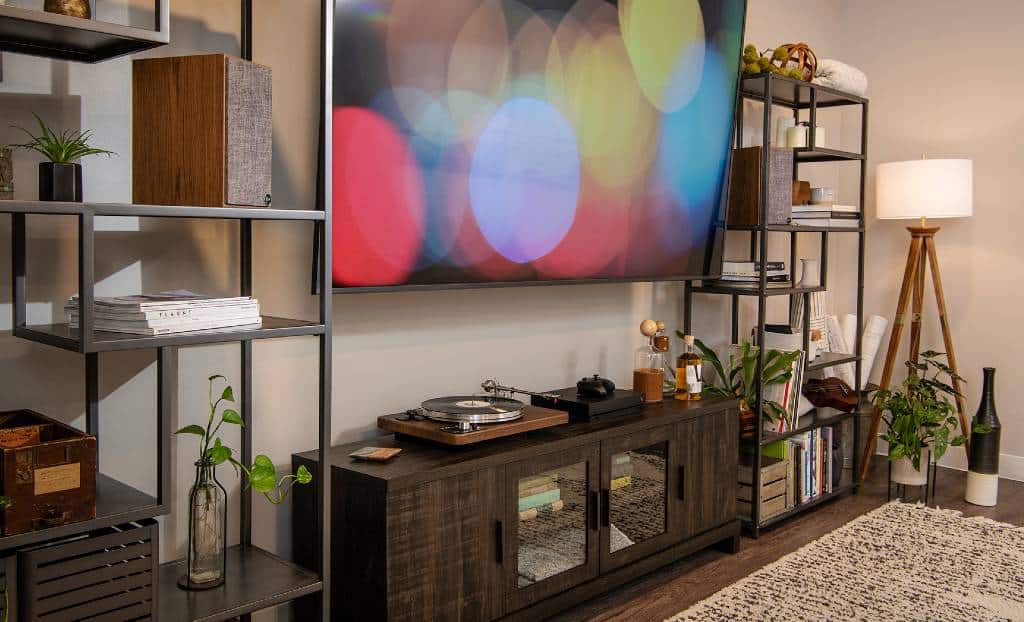
Which brings us to The Fives. An oddly named set of compact speakers billed by the manufacturer as “… the most versatile speakers on Earth”. The Fives, eh? What’s that about? Well, first there were The Sixes, which were apparently named after their six-inch drivers, except they’re actually 6.5” units. The Fives have 4.5” drivers. I suppose calling them The Six and a Halves or The Four and a Halves would have been a bit silly. Regardless of the naming protocols, what we have here are a premium set of powered bookshelf/stand-mount speakers with a wide range of connection options.
They’ve obviously been designed to be suitable for both hi-fi and home theatre use. Besides high-res audio capabilities, there’s also a built-in phono stage indicating real intent to get down and play some music. There’s also an HDMI-ARC input offering seamless integration with a modern TV, which gives them real credibility in a home theatre environment.
Construction
At only a foot tall, The Fives are compact – 304.8mm x 165.1mm x 234.95mm to be precise. They’re also powerful, with no less than 160w available to the drivers – 60w to each woofer and 20w to the 1” titanium tweeter (loaded with one of Klipsch’s Tractrix horns). And they’re versatile because, in addition to the phono and HDMI inputs, there are also Bluetooth, optical, USB, analogue RCA, and 3.5mm mini-jack connection options. It’s hard to be picky with all those choices on offer, but in a perfect world, I would have liked to see AirPlay available as well. However, that’s not a deal-breaker by any means.
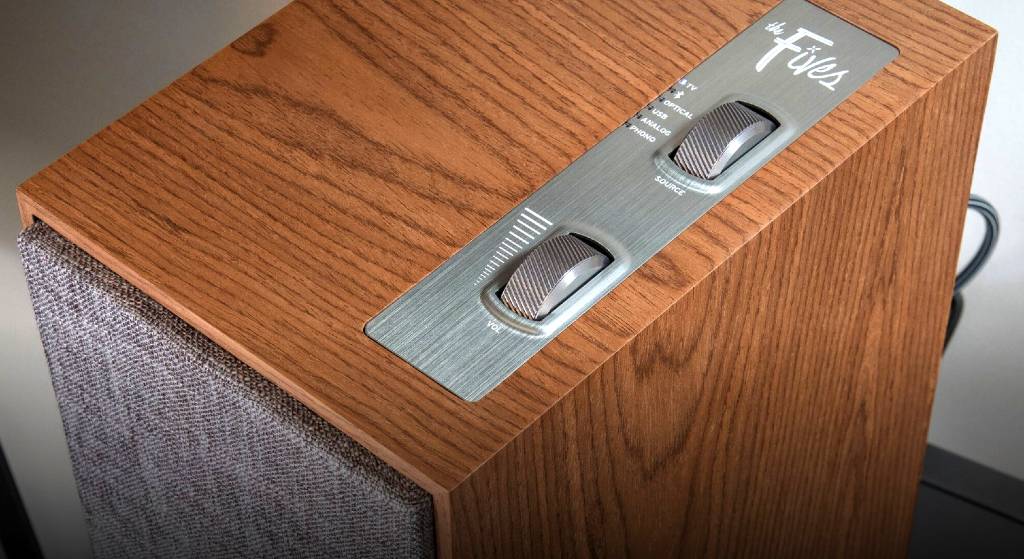
At $1800, there’s no doubt that The Fives are an upmarket choice, but the build quality and appearance are spot on at that price point. The matt walnut finish of the review units looks and feels fabulous, more like real wood than a veneer. They’re also available in a matt black finish, but it’s hard to beat the warm, tactile texture of wood. With the magnetic cloth grilles fitted, The Fives are gorgeous. They’re like throwbacks to a more elegant and considered era – so much so that they’d be right at home on a 1960s gentleman’s bookshelf. Grilles on review speakers are usually left off when I listen to them, but these deserve to be left on, purely for the way they add beauty to a room.
Only one speaker (the right hand one) has inputs, controls, and amplification, while a supplied four-meter cable links the secondary speaker. It’s possible to choose which speaker is the left or the right if it’s easier to have the primary speaker on the left, which is a nice touch. Controls are limited to a rotary source selector and volume control on the top of the primary speaker, with white LED lights indicating the selected source.
The volume control needs a lot of movement to achieve substantial changes in levels. This allows for fine control of volume, but if I’m being utterly pedantic, the wheel doesn’t feel as good as it could and probably should feel at this price. It’s entirely functional, but it would have been a fantastic addition to the overall pride of ownership if it was a well-damped and smooth, step-less control much like the frequency selection control on a vintage tuner.
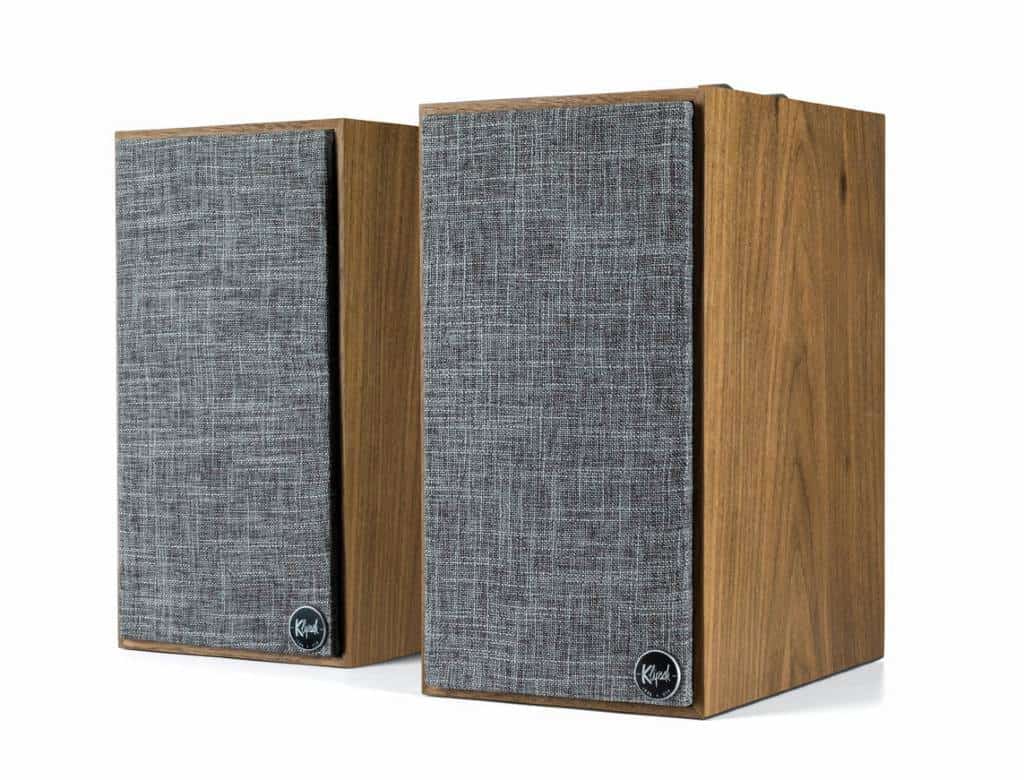
Another consideration of the control layout is that the source lights (which also indicate volume level) are hidden from sight when you’re seated. This isn’t all that big of a deal because the remote is how most users will interface with The Fives.
Something else to bear in mind is that the RCA analogue input does double duty as both the line and phono level input. A switch on the back of the primary speaker allows the user to select which is in use. Only a small fraction of potential users will want to, let alone need to, have a turntable, and another analogue source connected simultaneously. If they do, there’s always the option to use an RCA to 3.5mm adapter and connect using the 3.5mm input instead.
Sound Quality
The NZ Klipsch agents said that I’d probably be impressed by these speakers, especially the fact that they had a fair amount of bass power despite their compact size and a small 4.5” main driver.
As it turns out, despite my scepticism, they were right. I set them up, connected my iPhone via Bluetooth, and hit shuffle before heading to the kitchen to cook lunch. Upon my return, the first thing I noticed was a frankly shocking level of bass emanating from The Fives. ‘Smash the Funk’ from GRiZ’s Mad Liberation album was playing, and those little drivers were doing the business. Admittedly, this was in a small room, but the speakers were a fair distance from the back wall.
Most notably, this bass was present at low volume levels, which made the performance even more impressive. Besides the contributions of the 4.5” long-throw woofer and the rear-ported cabinet, the Klipsch website mentions that “Built-in dynamic bass equalization delivers powerful bass at any volume”. Let’s chalk one up for the engineering team at Klipsch because that’s no mere claim from the marketing department.
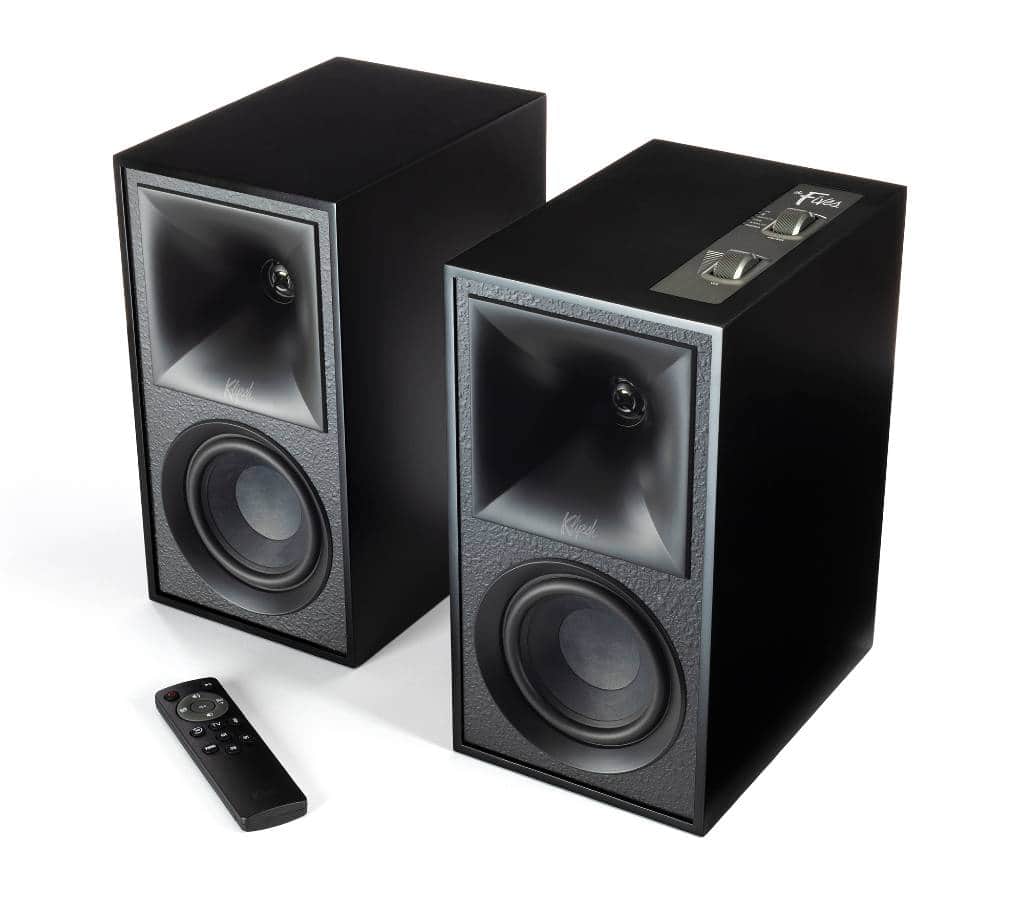
The spec sheet says the frequency response of The Fives is 50Hz -25kHz, but there’s no mention of how many dB down that roll-off is. There’s also a cryptic mention that the Dynamic Bass Extension is 46Hz at 35% volume. This blurb from the spec sheet goes on to explain the dynamic bass extension as follows:
“As the human ear perceives frequencies differently with variations in output, The Fives will dynamically match the ear’s ability to hear lower frequencies. Typically, only available with audio/video receivers, dynamic volume is a first for Klipsch powered monitors. What you get is powerful bass whether the listening volume is low, cranked up or somewhere in between.”
So in a way, it’s a newfangled, automated loudness control. At one point in my audio-nerd evolution, when I was a purist dingbat, this would have provoked The Raised Eyebrow of Scorn. These days, I’m more than happy for audio engineers to use technology to improve the listening experience. This boosted bass might not be the perfect reproduction of the recording, but if it works, it works. And in this case, it most definitely does because it’s not a clumsy implementation that creates a boomy mess.
Some hi-fi systems sound flat and lifeless at low volumes, with the sound collapsing into something resembling a portable radio. Not so these speakers. Horn-loaded speakers tend to be an exciting way to listen to music. Combined with the dynamic bass enhancement, at low volumes, this proved to be the case. Multiple genres of music were fun to listen to at volume levels that would be well suited to late-night listening in an apartment, or a home office when the kids are sleeping. The dynamic bass can be disabled from the remote, but at lower volume levels, there’s no reason in the world to do so because they sound much nicer with it enabled.
Next up was REM’s epic ‘Country Feedback with guest Neil Young’ from The Bridge School Concerts 25th Anniversary Edition. The Fives had no trouble rendering all the emotion in Michael Stipe’s voice or making the guitar and bass sound just right – full of depth, resonance, and even implied sadness. Yes, it’s clear that I love this version of the song, and I loved the way these speakers played it, regardless of whether they were turned way down low or cranked up loud. Bear in mind that at this point, I was still streaming at subdued levels via Bluetooth at 320kbps from my phone. Not a CD player or high-res DAC in sight but I could have listened all day.
‘The Grey Ship’ from EMA’s Past Life Martyred Saints album starts with a breathless vocal and some sparse instruments before the bass line and the other instruments come in almost three minutes into the song. The Fives do a superb job with this track, initially making the vocal sound hauntingly clear, placed perfectly in the centre of the sound stage. Then they deliver the bass with more than enough control, weight, and authority to make this song as enjoyable as it should be. Despite not being tiny, The Fives are particularly adept at that mini monitor trick of vanishing into space, where there’s no sense whatsoever that you’re hearing a pair of speakers.
An excursion into high-quality playback was inevitable given the built-in high-res capable USB input lurking round the back of The Fives. Connection to a Lenovo Y545 laptop was quick and easy. A selection of CD-quality and high-res FLAC flies revealed that The Fives have the kind of abilities that’ll please even a dedicated audiophile.
Chantal Chamberland features on the HD Tracks 2020 Hi-Res Sampler album, with a performance of ‘I Put A Spell On You’ that’s just beautiful. To put it simply, The Fives sounded lovely, with a deep and wide soundstage, swathes of detail, and no sense of harshness or brightness to the vocals. One of the concerns with horn-loaded tweeters is that they can sound harsh. While we’re dealing in generalizations, let’s also add that Titanium tweeters can be said to have the same reputation. This one is smooth enough, and while you could argue that this tweeter isn’t quite as refined as a good soft dome, the differences are minor. The energy and insight it adds to the presentation are well worth any potential compromises.
The acid test is whether or not the speakers sound like they need a touch (or a lot) less volume. If this happens often, there’s a problem somewhere in the audio chain. This was never the case except with the poorly recorded or bright tracks that I usually want to turn down on most systems – even the extra-forgiving Bose system in my car. So again, the Klipsch engineers have made some shrewd judgements here. At extreme volume levels (and they can go pretty loud), The Fives sounds like they’re being overworked. This isn’t a negative because, in this size range, only certain studio monitors sound good when they’re turned up to 10. Small speakers have their physical limitations, but The Fives do exceptionally well within those limits.
An old favourite high-res test track that I’ve been listening to for ages is ‘No Sanctuary Here’ by Chris Jones, initially released by Stockfisch Records back in 2003 on Roadhouses & Automobiles. Dragging out an old cliche, The Fives sounded like a more expensive speaker on this superbly recorded track, with an ability to resolve fine detail and nuance that was unexpected. Played loud but not flat out in a large room, they don’t sound like a small pair of speakers, not at all. There is a presence and sense of scale and impact that’s out of proportion to their size, thanks in no small part to the quality and quantity of bass they deliver.
With some bass-heavy tracks, there’s a little too much low-frequency output even at low levels but this was an occasional issue at worst. You’ll definitely want to disable the dynamic bass system when the volume is up because it’s too much of a good thing. However, enabling or disabling this functionality takes a few seconds from the remote control, so it’s no hassle to get the best of both worlds depending on the situation.
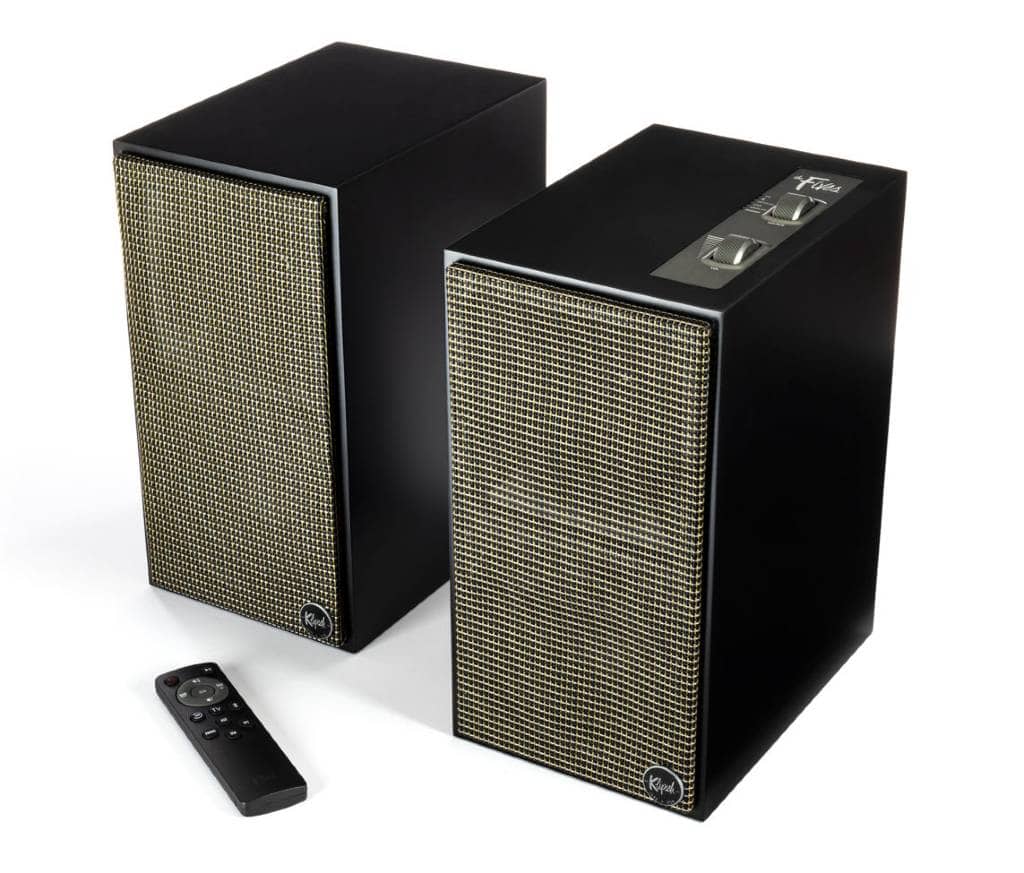
Turning To Television
In addition to their skills with music, The Fives turn out to be excellent TV speakers. While the sound quality of thin flat-panel screens has improved in leaps and bounds from the early days, there’s still a compelling case to be made for adding a more capable speaker system. Better sound equals more engagement and enjoyment every time.
Hooking these speakers up to a TV was as easy as connecting the HDMI cable and telling the TV to send the sound to the right place. Note that an HDMI-ARC capable TV is required, this won’t work with a conventional HDMI connection, in which case, there’s the optical input to fall back on. As expected, the sound quality was miles ahead of the Samsung TV’s internal speakers with dramatically more bass, increased clarity, and far better dynamics. Watching Taylor Swift’s Reputation Stadium Tour on Netflix was so much more involving than through the TV speakers – it was effectively an entirely different audio-visual experience.
The bass weight and depth were again notable, and while it won’t match a good soundbar with a subwoofer, there’s more than enough to do the job with music and movies. In any event, The Fives will kill all but the very best soundbars in terms of musicality, refinement, and outright detail, and there’s a subwoofer output to make adding more bass an uncomplicated task.
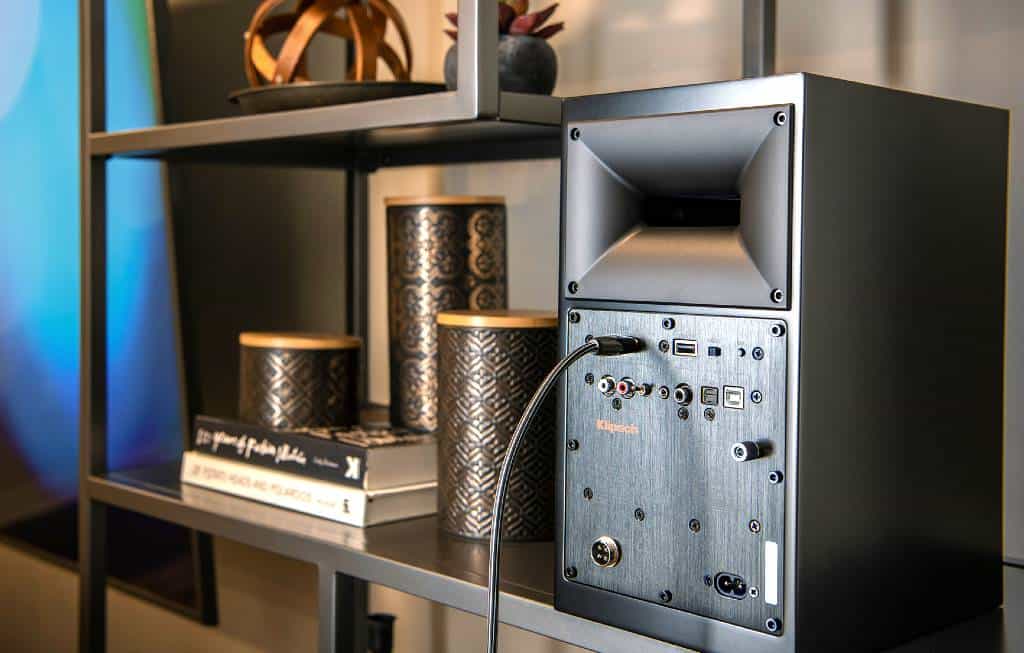
Conclusion
A significant question that needs to be answered with powered speakers like The Fives is whether a buyer can get more value for money by going down the hi-fi separates route instead. Could you buy an integrated amplifier, speakers, and cables for $1800 and get similar sound quality? Can you match the finish and build quality on offer here, especially with those gorgeous grilles in the equation?
I daresay it’d be a tall order, and probably impossible if you also wanted to duplicate The Fives’ connection options and flexibility, including high-res USB, a phono stage and an easy way to connect to a TV. I didn’t get a chance to test the phono stage, but the very fact that there’s also a phono option with all the other goodness is remarkable. Operationally, they were flawless, which is refreshing because minor glitches are almost expected when dealing with so many ways to connect to sources.
Whether they’re used as TV speakers, hi-fi speakers, or even as near-field monitors in a desktop setting, the Fives make a persuasive case for themselves. Their ability to sound so good at low volume levels is going to be particularly appealing to some buyers – this was one of their most endearing characteristics during the review. I spent many hours at night quietly listening to them at levels that most speakers wouldn’t be happy with, and I enjoyed every second. But slam the volume up, disable the dynamic bass, and they sound big and rambunctious while managing to retain a great deal of the refinement and insight into the music that makes real hi-fi audio so addictive.
They made music fun every minute they were playing, while simultaneously looking great. Klipsch’s The Fives are hugely versatile, premium speakers that come highly recommended by this reviewer. I’m looking for a set of small powered speakers, and these are on my shortlist for sure!
FREQUENCY RESPONSE: 50Hz – 25kHz
DYNAMIC BASS EXTENSION: 46Hz @ 35% Volume
MAX OUTPUT:109 dB (1M Stereo Pair)
POWER: 160W Total System Power (320W Peak) 60W LF, 20W HF
TWEETER: 1” (2.5cm) Titanium LTS vented tweeter with Tractrix® horn
LOW FREQUENCY DRIVER: 4.5” (11.43cm) high-excursion fiber-composite cone woofer
ENCLOSURE MATERIAL: MDF with genuine wood veneer
ENCLOSURE TYPE: Bass-reflex via rear-firing port
INPUTS: HDMI-ARC with CEC
Bluetooth® wireless technology
Phono/Line analog (with switch and ground screw terminal) \
3.5mm analog mini jack
USB digital
Optical digital
OUTPUTS: Single RCA line level output for connection to subwoofer
DIMENSIONS: 12” (304.8mm) x 6.5” (165.1mm) x 9.25” (234.95mm)
WEIGHT: Primary: 11.8 lbs (5.35kg) – Secondary: 10.7 lbs (4.85kg)





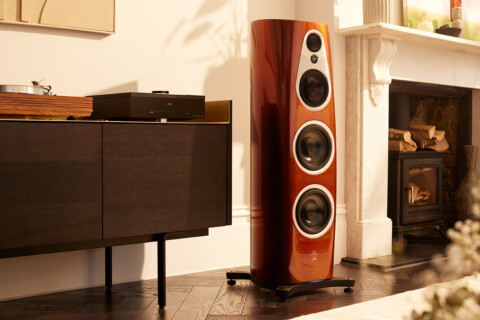
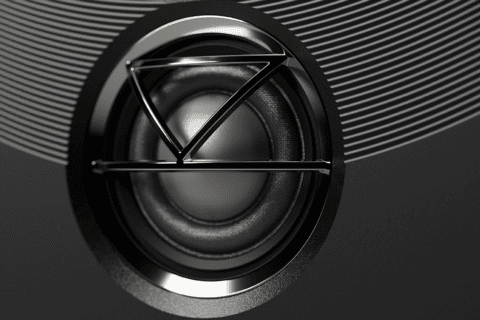
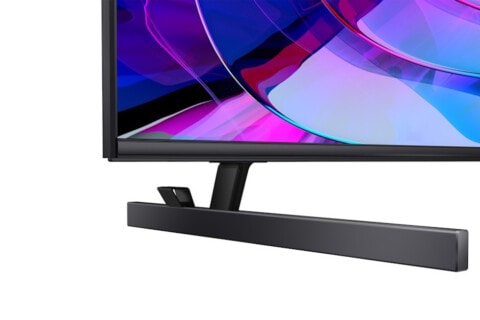
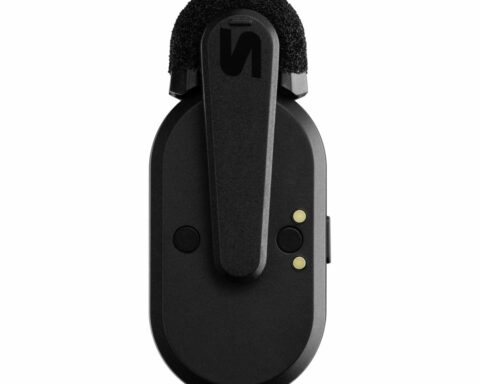
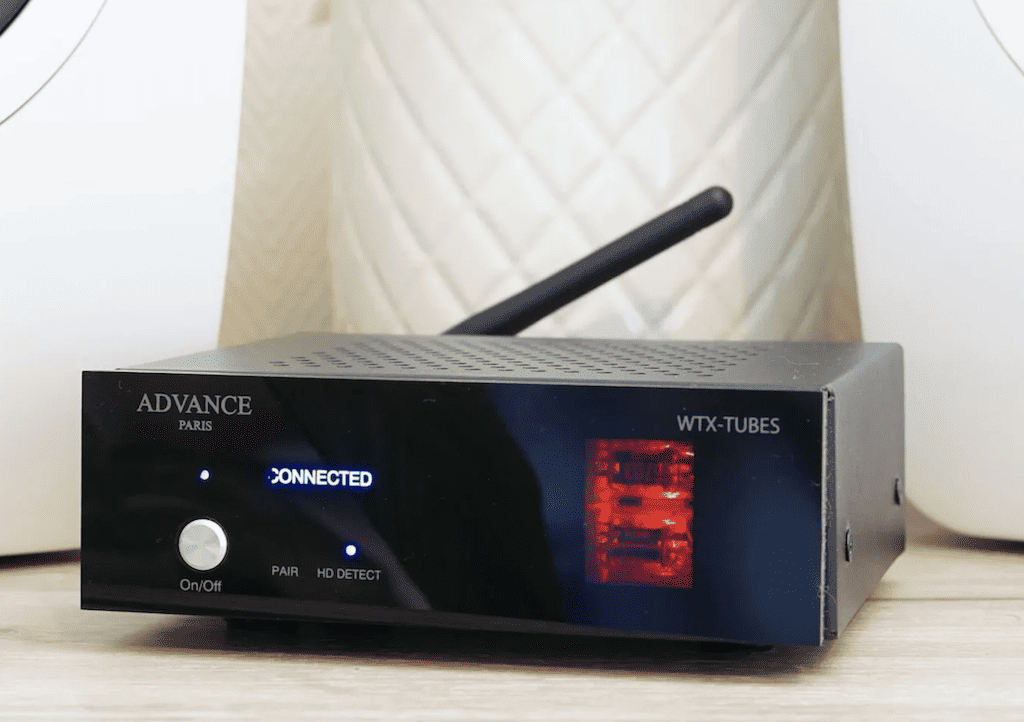

Active speakers are where it’s at, once you go there you can’t go back. The recording and live industries have been here for years. It’s taking the so called HiFi industry years to change but still dwells in separates as a virtue. The loudspeaker driver amplifier interface is critical and active is the future. Trying to match amplifiers to speakers is fraught with numerous problems. All you need to do is add an active subwoofer with an active crossover to these Klipsch speakers and you have a greater sound than separates will give you.
I think the price is $699 not $1800
I like her review of the five’s , but to say home theater has e lived into sound bars let me know this person has little knowledge or interest in home theater. While soundboard have improved dramatically, especially ones that offer immersive audio, they are not even a substitute for discrete systems, but rather a compromise for people who aren’t enthusiasts, but want a better sound experience. To suggest otherwise is either extremely ignorant or disingenuous.